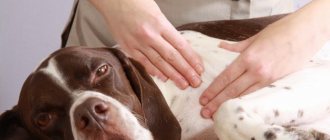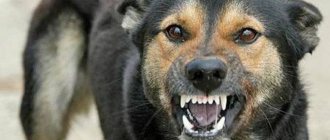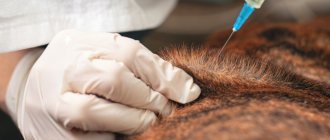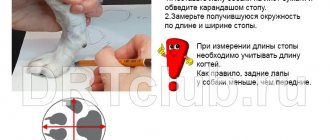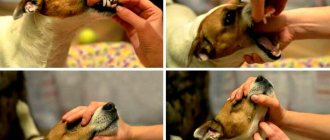A pet may face various difficulties, one of them is paralysis of the hind limbs. Pathology is an extremely serious disorder that, without appropriate assistance, quickly leads to disability. The deviation is difficult, but can be treated, so you need to show maximum care and hard work. One of the main methods to cope with this illness and improve the pet’s well-being is massage. We’ll talk further about how exactly a dog should be massaged if its hind legs are paralyzed.
Massage for a dog with paralysis of the hind legs
Causes of hind leg paralysis
Many factors have been identified that lead to the development of paralysis of a pet's hind legs. Among them are:
- traumatic injuries . Any fractures, sprains and tendon ruptures can not only significantly limit the dog’s motor activity, but also damage peripheral nerve fibers. As a result, innervation is disrupted and paralysis develops;
- neoplasms . Malignant and benign tumors affect the nervous system in 4% of cases. Any localization of the proliferative process (in the brain and spinal cord, not in the periphery) can disrupt the functions of the nerve trunks. Also, impulse conduction can be changed when nerve tissue is compressed by nearby pathological foci;
- joint diseases – arthritis, arthrosis;
Arthritis and arthrosis
- spinal pathologies . Herniated intervertebral discs, discopathy, and scoliosis disrupt the normal anatomy of the spinal canal, during which the spinal cord can be compressed in any area and the innervation ceases. The higher the localization of the lesion, the more organs lose their function. For example, damage to the thoracic or lumbar spinal cord leads to denervation of the pelvic organs;
- degenerative bone diseases. Spondylosis (spike-like growth of vertebral tissue towards the spinal cord), spondyloarthrosis (protrusion of the annulus pulposus of the spinal disc), discopathy (penetration of disc components into the brain canal) provoke compression of nerve cells. Against the background of long-term adverse effects, adequate oxygen supply is disrupted and nerve tissues die;
Spondyloarthrosis on x-ray
- unsuccessful movements . Prolapse of spinal discs, dislocations and fractures of various parts of the axial bone formation can occur with excessively active movements and unsuccessful turns;
- allergic polyneuropathy . Allergopathology can affect any organs, including the nervous system. Deviations occur when exposed to any allergens: household, medicinal, food, etc.;
- viral and bacterial infections affecting the spinal cord or brain (myelitis, meningitis, encephalitis, etc.). Not only damage to nerve fibers with the development of edema and destruction in them is dangerous, but also the action of poisons and toxins of pathogens;
- ischemic and hemorrhagic strokes . Pathology can occur due to various reasons: atherosclerotic damage to the vessels of the central nervous system, stress in the dog, increased blood pressure, massive injuries. As a result, a specific part of the nervous system is shut down.
Compression of the contents of the spinal canal
Which breeds get sick more often?
The disease usually affects medium and small breeds. Dachshunds, Brabançons, Pekingese and French bulldogs have a hereditary predisposition to intervertebral disc disease. Isolated discopathy is usually characteristic of very large breeds in old age. These include Doberman Pinschers, German Shepherds and Rottweilers. The deviation can progress throughout life and not appear at all.
Different dog breeds are prone to different types of paralysis
Pathologies of the musculoskeletal system are more common in shepherd dogs, Labradors, Great Danes and St. Bernards. The main reason is hip dysplasia, caused by the intensive growth of the animal’s body in the period from 4 to 10 months. Small breeds of dogs are prone to increased trauma. Typically, animals' paws suffer from minor falls, car injuries, and conflicts with representatives of other breeds.
Bulldogs have a hereditary predisposition to intervertebral disc diseases
Some tips
Before giving your dog a massage, check out the following advice from veterinarians:
- You will need a basic knowledge of canine anatomy and physiology. You can learn about the characteristics of the animal’s body from a veterinarian. You can also find this information yourself on dog breeding websites.
- During the procedure, turn your pet over to massage first one side and then the other. Try not to press on the stomach; this part of the body can only be lightly stroked. Otherwise, the abdominal organs may be damaged.
- If your pet is diagnosed with a serious illness, then it is better to entrust massage treatments to a specialist.
- If you give a preventative massage to a healthy dog, then the procedures should be regular. Try to spend at least 10 minutes on this every day. This will be a good prevention of the development of arthritis.
- If your pet is healthy, then pay attention to its reaction to the procedures. If the dog shows dissatisfaction (growls, flinches), then do not force it. You need to gradually accustom your animal to massage.
Classification of paralysis
The disease is always associated with damage to the nervous system. Depending on the severity of the deviation, scientists systematize it as follows:
- monoplegia - paralysis of one leg;
- paraplegia - the lesion involves the front or hind limbs;
- tetraplegia – lack of innervation of all paws;
- hemiplegia – the right or left half of the body is immobilized;
Depending on the severity of damage to the central and peripheral nervous system and etiology, there are:
- functional paralysis . Occurs against the background of exposure to negative factors (toxins, swelling, stress). The phenomenon disappears after the cause is eliminated;
- organic paralysis . The basis is damage to neurons, the function will never be restored. Often the cause is trauma, tumors, and irreversible infectious and inflammatory processes.
Paraplegia in a dog
Localization is an important diagnostic sign. Paralysis occurs:
- central (the brain and spinal cord are affected);
- peripheral (deviations are detected from the peripheral nerve fibers).
They also highlight:
- paralysis (decreased muscle strength with limitation of motor and functional activity);
- paresis (complete impossibility of movement).
Contraindications
There are times when massage is contraindicated. This procedure should not be done under the following conditions:
- fever;
- any damage and lesions of the skin (eczema, tumors, wounds, pustules);
- bleeding;
- fresh bone injuries with severe pain;
- epilepsy;
- severe liver and kidney diseases;
- shocked.
If your dog has at least one of the listed contraindications, then refuse massage. Otherwise, the treatment procedure will do more harm than good.
Symptoms of the disease
Dragging paws behind you
Clinical manifestations may vary. The rate of development of pathology also differs significantly. In some cases, the disease progresses quickly (injuries), leading to disability of the animal within a few minutes, in others it lasts for years (tumors, discopathy, etc.) The following main symptoms can be identified:
- loss of ability to move independently. The dog can walk while leaning on walls or other interior objects. In isolated forms, one or more limbs may drag after the dog along the floor or ground;
- unsteadiness of gait. The animal moves uncertainly, staggering;
- frequent stumbling. Weakened or absent muscle strength leads to decreased range of motion. The pet touches any small obstacles - stones, carpets, thresholds. An additional danger is introduced by the possibility of injury and infection (in denervated areas the immune system does not function adequately, creating a favorable environment for the proliferation of microorganisms);
- asymmetry of the body and limbs. Paralysis or paresis leads to the impossibility of movement, decreased muscle tone, which disrupts the functional and aesthetic anatomy of the animal.
Unsteady gait as a sign of paralysis
When the pain syndrome is severe, the animal is restless and rushes around the room, even if this is not completely successful. In rare cases, if the lesion is in the brain, the disease is combined with attacks of convulsive seizures. They can be limited (one limb twitches) or generalized (convulsions cover the entire body). Systemic convulsions are a dangerous phenomenon, since during them the animal’s breathing stops due to spasm of the circulatory fibers of the larynx.
Relieving pain
How to massage a dog if something hurts your pet? The procedure technique is as follows:
- Place the dog on a blanket or the floor, make petting movements and talk to the dog in a soft voice.
- Rub your shoulders, neck and back in circular motions, as if you were kneading dough. Do not put too much pressure on your body, as this may increase the pain.
- Gently stretch your paw muscles. Move from their base down. Don't forget to massage your fingers.
- Direct impact on the source of pain is prohibited. You can only stroke and knead the muscles around the sore spot. This will help improve blood circulation and reduce discomfort. Be especially careful if your dog suffers from cancer. Try not to touch the tumors, this may provoke their growth.
- Complete the procedure by lightly stroking the entire body from head to tail and each paw.
Diagnostics
Statistics show that dog owners turn to veterinarians for help even when the animal completely loses the ability to move independently and causes a lot of inconvenience. In diagnosis, it is extremely important to know the duration of the disease (for example, various viral infections have their own developmental characteristics and different incubation periods).
A visual examination allows you to immediately make a correct diagnosis. The veterinarian checks the integrity of deep and superficial sensitivity and identifies reflex pathologies.
Paralysis of both hind legs is not difficult to detect
However, the cause of the pathology is extremely important, since treatment will be aimed specifically at it. The dog undergoes a whole range of laboratory and instrumental activities:
- general blood test (an increase in the level of leukocytes and neutrophilia will indicate the bacterial nature of the infection, and leukopenia in combination with an increase in the number of lymphocytes indicates a viral infection);
- biochemical study of blood composition (rheumatic factors are especially important, allowing one to judge the autoimmune process);
- specific tests to search for antibodies to pathogens;
- ultrasound examination of the extremities (allows you to visualize the lesion, identify swelling and the current location of nerve fibers);
- X-ray is the best method for diagnosing fractures and bone deformities;
- CT or MRI (methods provide a complete picture of what is happening in the central and peripheral nervous system of the dog and allow, in almost 98% of cases, to make the correct diagnosis).
Video - Failure of hind legs in dogs
Life prognosis for dogs with discopathy
The life prognosis for dogs with this diagnosis is very good. Veterinarians assure that timely started therapeutic treatment “puts about 70% of sick animals back on their paws” without surgery. The main thing is to strictly follow the doctor’s recommendations and take medications according to the schedule. If the animal is overweight, then it is necessary to get rid of it, as this leads to a relapse of the disease.
To prevent relapses, it is useful to do physiotherapeutic procedures, massage and make your pet swim, as this forms a good muscular frame in the animal.
A healthy spine means a vigorous, active and cheerful dog!
Authors of the articles: Belanta Clinic team
Complications
Paralysis can lead to other more serious consequences and further aggravate the general condition. These include the following:
- rapid muscle atrophy . Muscles that have lost their mass find it more difficult to become active. Therefore, without massage and physiotherapeutic procedures, the animal will never return to its normal life;
- the appearance of contractures . If the pet does not make passive movements, imitating physiological ones, then the joints gradually ossify;
- bedsores _ A long-term immobile position contributes to the appearance of areas of necrosis on tissues in contact with the floor;
- development of other diseases . Physical inactivity leads to hypostatic pneumonia and an increased risk of blood clots, which can cause death.
Does it help?
The benefits of massage are priceless. The main condition is to carry it out correctly. If the dog owner is not confident in his actions, then it is advisable to trust a professional.
Massage treatments help:
- Blood circulation improves in the area of the body that is exposed. Tissues are actively supplied with oxygen, metabolism improves, and the regeneration process is noticeably accelerated.
- Muscle tone and reflexes are activated. Mechanical impact prevents muscle atrophy.
- Massage has an analgesic effect . When exposed to fatty tissue, biological active substances begin to be produced that have an analgesic effect.
- The conductivity of nerve impulses increases. And restoration of nervous tissue is the basis for animal rehabilitation. If you massage correctly, the dog will be able to quickly restore its lost activity.
- Relaxation of the body , which brings temporary peace.
The massage should begin with light stroking movements. There is no need to immediately start with therapeutic actions. It is necessary to obtain the pet’s trust and consent to the manipulations being carried out.
Reference! In combination with therapeutic massage, many owners resort to aqua massage. The dog is placed in warm water for about twenty minutes. Hydromassage waves affect blood circulation, increase muscle tone and relax your pet.
Treatment
Treatment tactics depend, first of all, on the etiology of the disease. If the cause of the deviations is fractures, dislocations or ligament ruptures, then the limb is immobilized with a plaster cast or tight bandage for a certain time (usually 3-6 weeks).
How to recognize a fracture in a dog
Neoplasms are subject to surgical excision, followed by chemotherapy to prevent the growth of metastases and tumor recurrence. In some situations where cell proliferation is unresectable, palliative radiotherapy may be prescribed. The lesion is exposed to X-rays that destroy the tumor.
For bacterial or viral infectious and inflammatory processes, antimicrobial and antiviral agents are prescribed. The dosage regimen is indicated in the table.
Table 1. Drug treatment of infections due to paralysis in dogs
| Name | Dosage | Frequency of application | Duration of treatment | Spectrum of action | Method of administration |
| Amoxicillin | 20 mg/kg | 2 times a day | 4-8 days | Bacteria | With food |
| Azithromycin | 4 mg/kg | Every 24 hours | 10 days | Bacteria | With food |
| Neomycin | 15 mg/kg | 1 per day | 10 days | Bacteria | With food |
Ribotan | 2 ml | Every 8-12 hours | 3-5 days | Viruses | Subcutaneous/intramuscular |
Spinal lesions, as a rule, are not radically corrected and are subject to symptomatic therapy. An excellent tool for reducing the activity of the inflammatory process (especially of an autoimmune nature) are systemic glucocorticosteroids. For example, Methylprednisolone (1 mg/kg 2 times a day).
In order to reduce the severity of pain, the use of non-narcotic analgesics is indicated. Nonsteroidal anti-inflammatory drugs are excellent: Ketonal (1 mg/kg body weight per day), Vedaprofen (0.5 mg/kg 2 times a day, but not more than 10 mg per day). This group of drugs has not only an analgesic, but also an anti-inflammatory effect, helping to reduce and delineate the source of inflammation. The duration of treatment, for safety reasons, should not exceed 14 days.
The drug Ketonal in capsules
Increased load on the muscles due to impaired innervation of the limbs always leads to muscle overload. Antispasmodics are indicated to reduce spasm and tension. The banal No-shpa or Baralgin . Dose – 1 tablet per 10 kg of dog weight per day. The course of treatment is until the symptoms disappear completely.
Baralgin tablets
The doctor can also prescribe multivitamin preparations that necessarily contain B1, B12 and PP. One of these medications is the vitamin supplement “Vitamins”. The duration of therapy is 2 months, and the daily dose for a weight less than 10 kg is 3 tablets, from 10 to 20 kg - 5-6, from 30 to 40 - 7-8, and for a body weight over 40 kg - 10 tablets.
Attention! The use of any drug should be carried out only after consultation with a veterinarian on his recommendation. Self-treatment without undergoing examination in a clinic is fraught with life-threatening consequences.
How to do?
The dog's recovery will depend on its owner. The sooner the owner notices problems, the higher the animal’s chance for a normal life.
First of all, you need to show your pet to a veterinarian, who will assess the severity of the disease and prescribe adequate treatment. These could be medications with complex measures, or maybe just one massage will be enough.
The massage consists of two stages:
- Preparatory, relaxing.
- Hind limb massage.
You can go to a veterinary clinic for the procedure or learn how to massage yourself. The doctor will show you how to act correctly so as not to harm the animal.
Preparatory stage
The animal needs to be relaxed and prepared; this stage cannot be skipped.
Technique:
- Prepare the place , cover it with a blanket, blanket, rug. The warmth will help your dog relax during the procedure. Under no circumstances should you place a thick blanket or pillow.
- Determine the time for the massage. It is advisable to do it at the same interval.
- After eating, the procedure can be started only half an hour later, not earlier.
- Limit the effect of external irritants. The dog must be in a calm state. Many owners even turn on music, which helps the animal relax.
- When the dog is ready, you can start stroking it affectionately . You should start from the head and move your hand along the body to the tail. The hand should be fully open and cover as much of the animal’s body as possible. Act with confidence. Hands should be warm.
- After stroking, you can start back massage . You need to massage every muscle, start from the shoulders to the base of the tail. Do not touch protruding bones and spine.
- Sacrum massage. Using an open palm, rub the animal's lower back in a circular motion.
- The stomach is a very sensitive area of the body in dogs. Therefore, if the pet does not allow itself to be stroked there, then there is no need to insist .
- The penultimate stage of a relaxing massage is stroking the head . The hands are placed on its sides and movements are made back and forth. If the dog is a small breed, then massage can be done with your fingers.
- The last stage is working with the tail . From its base to the very tip you need to walk with both hands several times. The tip of the tail should be slightly squeezed.
Attention! When massaging the tail, do not squeeze it too hard or pull it. This movement will cause a strong reaction from the dog, and it may even injure the spine. Your pet's trust in you will be lost.
Rubbing the limbs
If the dog has relaxed well after the first stage and reacts positively, then you can calmly begin massaging the hind legs.
Technique:
- Start massaging the hind legs one at a time. Light stroking movements from top to bottom several times, then from bottom to top.
- Gently wrap your hands around the base of the paw and its end. Perform slight flexion and extension of the limb. Actions must be performed 15 times. Monitor the condition and mood of the animal. If the procedure causes discomfort to your pet, then you need to reduce the load.
- Circular movements with each paw need to be done several times. Take a break between rotations and repeat again. Thus, the exercise is carried out up to three times.
- Use three fingers – index, middle and thumb – to stretch the muscles on your leg. Time at least two minutes for each.
- The pads of your toes should also be stretched. Grasp the limb and press lightly with your fingers about 20-25 times.
- The massage ends with kneading the spaces between the fingers.
- If during the procedure the dog begins to get nervous, it is recommended to end the massage with stroking the whole body.
Prevention
Any disease can be prevented. To prevent your pet from encountering such a serious problem, you should follow a few simple rules:
- early activation of the animal. From 1-2 months he should be allowed outside and allowed frequent contact with dogs of his age;
From the first months, it is important to accustom puppies to an active lifestyle.
- making time for rest. If your pet wants to sleep, do not disturb him;
- prevention of going down stairs until six months of age. It is better to carry small puppies in your arms, this will prevent injuries and fractures;
- undergo regular examination (including x-rays) for breeds at high risk of paralysis;
- adherence to diet. The food entering the dog’s body must be complete in qualitative and quantitative proportions, given in accordance with the preferences of the breed and age;
- exclude exposure to cold (air conditioning, tiles, drafts). The animal's permanent place of residence must be warm;
- regular sanitary cleaning and washing of all pet’s personal belongings without the use of hazardous chemicals.
Once every six months, the dog must be taken to the veterinarian for examination.
Massage for intestinal obstruction
In case of intestinal obstruction, the pet is prescribed a diet and the stomach is massaged. The problem most often occurs in puppies.
- Curtains with eyelets - what is their feature? Photo of beautiful design
Shoes for dogs - sizes, features of use and training for shoes of different breeds (85 photos)
How to cut dogs - step-by-step clear instructions for beginners on how to cut a haircut correctly at home (video + 90 photos of haircuts)
The procedure begins with stroking near the navel.
You should not touch the groin area because the dog will not like it, especially if it is an old animal. Before starting the procedures, a relaxing complex lasting 5 minutes is done.
